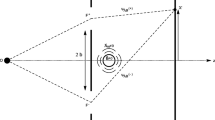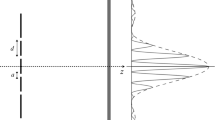Features of the propagation of a pulsed magnetic disturbance in a closed superconducting slit microwave transmission line are analyzed in the context of nonlocality of an action on a quantum object. It is suggested that, in contrast to previously conducted experiments with photons, such an approach enables us to specify the result of nonlocality of an action in a simpler situation with only a single component of the electromagnetic radiation.

Similar content being viewed by others
References
N. Bohr, Atomic Physics and Human Cognition [Russian translation], IIL, Moscow (1961).
W. Heisenberg, Physics and Philosophy. Part and Whole [Russian translation], Nauka, Moscow (1989).
M. Jammer, The Evolution of the Concepts of Quantum Mechanics [Russian translation], Nauka, Moscow (1985).
A. Einstein, B. Podolsky, and N. Rosen, “Can quantum-mechanical description of physical reality be considered complete?” Phys.Rev., 47, 777–780 (1935).
N. Bohr, “Can quantum-mechanical description of physical reality be considered complete?” Phys.Rev., 48, 696–702 (1935).
A. Einstein, N. Rosen, and B. Podolsky, “Can quantum-mechanical description of physical reality be considered complete?” Usp. Fiz. Nauk, 16, 440–457 (1936).
E. Schroedinger, “Die gegenwärtige Situation in der Quantenmechanik,” Naturwissenschaften, No. 23, 807–812, 823–828, 844–849 (1935).
J. von Neumann, Mathematical Foundations of Quantum Mechanics [Russian translation], Nauka, Moscow (1964).
K. R. Popper, Quantum Theory and the Crisis in Physics. From the Postscriptum to the Logic of Scientific Discovery [Russian translation], Logos, Moscow (1998).
D. A. Bohm, “Suggested interpretation of the quantum theory in terms of ‘hidden’ variables,” Phys. Rev., 85, 166–193 (1952).
D. Bohm, Quantum Theory [Russian translation], Fizmatgiz, Moscow (1961).
J. S. Bell, “On the Einstein–Podolsky–Rosen paradox,” Physica, 1, 195–200 (1964).
J. S. Bell, “Speakable and unspeakable in quantum mechanics,” in Collected Papers on Quantum Philosophy with a New Introduction, A. Aspect (ed.), Cambridge Univ., London (2004).
A. Aspect, P. Grangier, and G. Roger, “Experimental tests of realistic local theories via Bell’s theorem,” Phys. Rev. Lett., 47, 460–463 (1981).
A. Aspect, P. Grangier, and G. Roger, “Experimental realization of Einstein–Podolsky–Rosen–Bohm Gedanken-experiment: a new violation of Bell’s inequalities,” Phys. Rev. Lett., 49, 91–94 (1982).
X.-S. Ma et al., “Quantum teleportation over 143 kilometers using active feed-forward,” Nature, 489, 269–273 (2012).
C. Noelleke et al., “Efficient teleportation between remote single-atom quantum memories,” Phys. Rev. Lett., 110, 140403 (2013).
A. Peruzzo et al., “A quantum delayed-choice experiment,” Science, 338, 634–637 (2012).
F. Kaiser et al., “Entanglement-enabled delayed-choice experiment,” ibid., 637–640.
V. D’Ambrosio et al., “Experimental implementation of a Kochen–Specker set of quantum tests,” Phys. Rev. X, 3, 011012 (2013).
The Born–Einstein Letters: Correspondence between Albert Einstein and Max and Hedwig Born from 1916 to 1955, Walker, New York (1971).
S. L. Vavilov, “Experimental investigations of light quantum fluctuations by a visual method,” Usp. Fiz. Nauk, 36, Iss. 3, 247–283 (1948).
A. D. Grigor’ev, Electrodynamics and Microwave Technology [in Russian], Vysshaya Shkola, Moscow (1990).
J. S. Langer, “Coherent states in the theory of superfluidity,” Phys. Rev. Lett., 167, 183–190 (1967).
P. Hohenberg, “Long-range order in superconducting transition,” Usp. Fiz. Nauk, 102, Iss. 2, 239–246 (1970).
F. London and H. London, “The electromagnetic equations of the supraconductor,” Proc. Roy. Soc. A, 149, 71–88 (1935).
E. Linton, Superconductivity [Russian translation], Mir, Moscow (1971).
R. Feinman, Statistical Mechanics [Russian translation], Mir, Moscow (1975).
A. I. Golovashkin et al., “Ordinary SQUID interferometers and interferometers functioning on waves of matter in superfluidic helium: the role of quantum fluctuations,” Zh. Eksp. Teor. Fiz., 138, No. 2, 373–380 (2010).
Author information
Authors and Affiliations
Corresponding author
Additional information
Translated from Metrologiya, No. 7, pp. 18–28, July, 2013.
Rights and permissions
About this article
Cite this article
Zherikhina, L.N., Izmailov, G.N., Karuzskii, A.L. et al. Measurement of Nonlocality of a Magnetic Disturbance in a Superconducting Slit Line. Meas Tech 56, 981–987 (2013). https://doi.org/10.1007/s11018-013-0316-9
Received:
Published:
Issue Date:
DOI: https://doi.org/10.1007/s11018-013-0316-9




